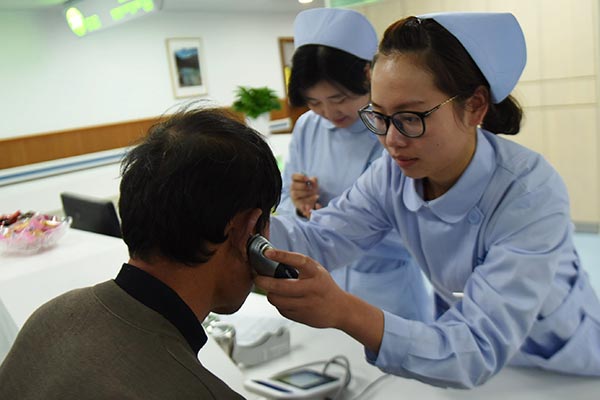Cutting-edge healthcare system possible
Updated: 2016-07-23 09:22
By JIM YONG KIM(China Daily)
|
||||||||
 |
|
A nurse measures body temperature of patients at a medical center in Hangzhou, Zhejiang province. LONG WEI / FOR CHINA DAILY |
China's innovations in health and cooperative healthcare decades ago showed the world that it was possible to improve healthcare and greatly increase life expectancy for hundreds of millions of people. As a result, more people in China than ever before received access to quality, affordable healthcare. Child and maternal mortality and rates of infectious disease plunged, and the health and life expectancy of the Chinese people improved remarkably.
In 2009, China embarked on a new phase of healthcare reform. It made major investments in health infrastructure, and health insurance coverage today is close to universal. A national essential medicine system is now in place, and out-of-pocket healthcare expenses for patients have come down by almost half, from 60 percent to 32 percent.
Despite this success, China now faces new challenges, which mirror those in many high-income economies. An estimated 140 million Chinese are above 65 years of age, and their number is projected to grow to 230 million by 2030. Cancer, diabetes, heart diseases and other non-communicable and chronic diseases account for more than 80 percent of the total 10.3 million deaths every year.
Chinese citizens are heavily dependent on hospitals, which account for more than half of healthcare spending, instead of primary care centers, which employ just one-third of health professionals. With higher personal incomes, people are also demanding more and better healthcare. These factors have led to rising healthcare costs that are growing while the country's economic growth rate is slowing.
Healthcare costs have outpaced GDP growth by 5-10 percentage points over the last decade. The World Bank estimates that, with business as usual, healthcare spending would increase to more than 9 percent of GDP in 2035, up from 5.6 percent in 2015. The Chinese government, however, has realized it needs to deepen the healthcare reform to meet its people's growing health needs and expectations at an affordable cost.
A new, sweeping two-year study released by the World Bank Group, the World Health Organization, and China's Ministry of Finance, National Health and Family Planning Commission, and Ministry of Human Resources and Social Security outlines a blueprint to deliver high-quality, affordable healthcare for all. The study recommends that China move toward a "people-centered" integrated healthcare system to meet its new challenges. The reform would shift the healthcare system from the current hospital-centric model that rewards volume to one that is focused on health outcomes, centers on primary care and offers better value for money.
Eight key changes to the healthcare system have been recommended. They include creating a new model of people-centered integrated healthcare that strengthens primary care as the core of the healthcare system, making a major investment in healthcare quality across the system, empowering patients with knowledge and understanding of healthcare services to increase their trust in the system and actively engage patients in making healthcare decisions, and reforming hospitals so they focus on complicated cases and delegate routine care to primary care providers.
The healthcare workers, especially the primary care providers, are seen as key to the reform's success and the recommendation is for them to be better paid and supported so that they become a competent workforce aligned with the new delivery system. The study also recommends that the government define a policy that provides space for the private sector in those areas where they can deliver cost-effective solutions, with the right regulatory environment and supervision.
Finally, the report focuses on prioritizing public investments according to the burden of disease, and the kind of care people need on a daily basis. Implementing these reforms could save China as much as 3 percent of GDP a year by 2035, while improving the quality of healthcare for its people.
I strongly believe that China will once again lead the way with cutting-edge healthcare reform that puts the patient first and improves the health and well-being of one in every six people in the world.
The author is president of the World Bank Group.
- Fashion of Queen Elizabeth on exhibition in London
- Hollande urges Britain to begin EU exit talks 'as soon as possible'
- Trump vows law and order if elected
- Chinese cuisine stuns Thai princess
- Security Council holds first secret poll on next UN chief selection
- Turkey's Erdogan declares state of emergency after coup bid

 Things you may not know about Major Heat
Things you may not know about Major Heat
 Unveiling the secrets of Elizabeth II’s wardrobe
Unveiling the secrets of Elizabeth II’s wardrobe
 Go global: Wanda's top 10 foreign acquisitions
Go global: Wanda's top 10 foreign acquisitions
 Hot pepper and ice tub challenge held in E China
Hot pepper and ice tub challenge held in E China
 Ten photos from around China: July 15 – 21
Ten photos from around China: July 15 – 21
 Heavy rain, floods across China
Heavy rain, floods across China
 Super-sized class has 3,500 students for postgraduate exam
Super-sized class has 3,500 students for postgraduate exam
 Luoyang university gets cartoon manhole covers
Luoyang university gets cartoon manhole covers
Most Viewed
Editor's Picks

|

|

|

|

|

|
Today's Top News
Ministry slams US-Korean THAAD deployment
Two police officers shot at protest in Dallas
Abe's blame game reveals his policies failing to get results
Ending wildlife trafficking must be policy priority in Asia
Effects of supply-side reform take time to be seen
Chinese State Councilor Yang Jiechi to meet Kerry
Chinese stocks surge on back of MSCI rumors
Liang avoids jail in shooting death
US Weekly

|

|







